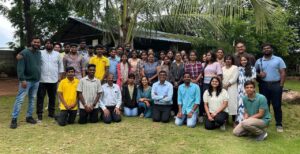Speaking at the Oxford Farming Conference this week, the managing director of a fresh produce supplier to leading UK supermarkets like Waitrose, presented some of the innovations his company is using in its operations.
Barfoots of Botley grows, processes, and packs a range of semi-exotic produce grown in the UK, Spain, Senegal, and Peru including sweetcorn, butternut squash, asparagus, sweet potato, chillies, legumes, peanuts, and onions.
The business’s UK farms, which are spread across 6,500 acres of leased land and involve rotations with a large number of others farmers, are 100 percent self-sufficient in energy. The company processes all its waste and trimmings into an anaerobic digester, which in turn produces energy and nutrients for crop fertilization. But Barfoot’s technological innovations go much further than that and are used across the company’s farms in Spain, Senegal and Peru too.
The company is currently undertaking 30 innovation projects as part of its plan to “maintain competitiveness, reduce environmental impact and enhance sustainability while also delivering products that consumers want”, said Julian Marks, MD of the company.
“Deciding which step-change science and technology to present today was a challenge as we have a huge number of projects going on. Some will succeed, and some will fail,” said Marks.
Here are three technologies that Marks presented as having delivered successful outcomes to the business.
Satellite-guided controlled traffic farming
Controlled traffic farming is a management tool to reduce the damage to soils caused by heavy and repetitive agricultural machinery passes on land. Adverse outcomes include increased fuel use, reduced crop yields and poor soil function.
Using satellite-based guidance systems for the precise steering of tractors on the least possible amount of land has resulted in the following positive impacts for Barfoots’ operations:
- diesel usage has fallen 15 percent
- rainwater draining more quickly off the land
- 30 percent less spent on artificial fertilizer
- soil compaction significantly reduced
The challenge of using this technology is the need for increased levels of collaboration with the farmers in rotation agreements with Barfoots, said Marks.
Controlled atmosphere shipping
Conscious of the carbon footprint of flying asparagus from Peru back to the UK during the UK winter, Barfoots looked into shipping the produce on a 16-day journey instead. Keen to ensure that each container holding 50,000 tonnes of asparagus reached the UK in fresh condition, the company explored controlled atmosphere technology.
Communication software in each unit enables Barfoots to see what’s going on in the container at all times and to know exactly where the ship is on its journey. It also allows the company to react if there is a technical issue such as a higher temperature.
So at the same time working with its Peruvian growers to ensure they are providing the highest quality asparagus, Barfoots has managed to refine the process and present fresh asparagus to UK consumers, despite the long journey.
And the carbon footprint of growing asparagus in Peru for sale in the UK is, in fact, lower than growing it in the UK, said Marks. The Peruvian climate enables the growth of 15 – 20 times more asparagus per acre than in the UK, using the same amount of chemical inputs. Since the manufacture of chemical inputs is one of the largest sources of carbon emissions, asparagus grown in Peru is much more efficient, despite the travel-associated emissions.
Selective breeding
Barfoots works with a number of different breeders globally looking for different genetics traits to grow produce in different climates, with a better shelf life, and with preferred flavoring and texture. “We have quickly identified specific genes and traits that we want,” said Marks.
Marks added that the business collaborates with a large number of Ph.D. students and public bodies in its research, which ranges from research into polyphenol extraction from vegetables for use in pharmaceuticals to the molecular pre-symptomatic identification of plant disease, as examples.
What technologies do you use? Get in touch on [email protected]
Image credit: Liz West on Flikr




